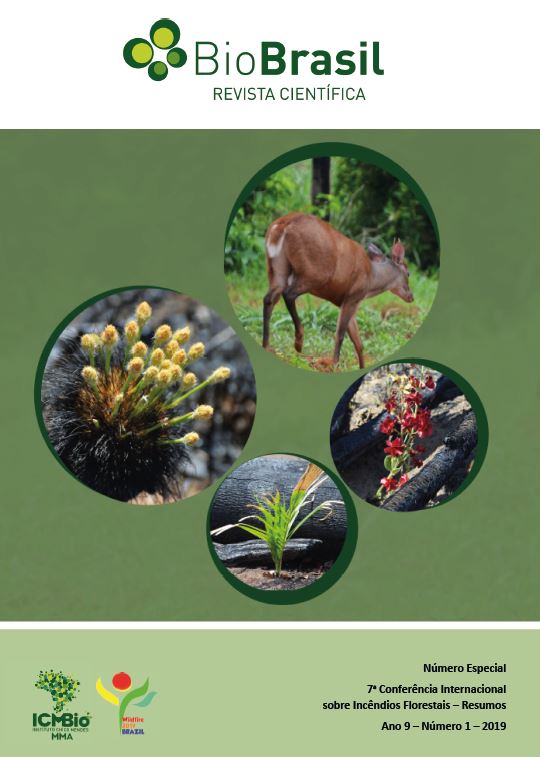The implications and activities related to integrated fire management in the wildland and forestry interface
DOI:
https://doi.org/10.37002/biodiversidadebrasileira.v9i1.1262Palabras clave:
ntegrated fire management, integration, risk, fire, prevention, protection, rehabilitationResumen
The need for mitigating the effects of unwanted fire, and its potential negative effects on the environment, has existed since humans first started using fire as a tool. It has developed to a point where only relatively recently the value of integration of the various aspects of fire management started to be understood by practitioners. Aside from a new understanding and the emergence of related technologies and techniques for integration, these are not yet widely applied. Working on Fire International is a leader in this field, having applied integrated fire management both to diverse land use areas throughout Southern Africa on a country scale, and also successfully implemented the full suite of integrated fire management services in the international arena. Its experience covers a varied range of circumstances from Africa through Australia, Indonesia to Chile. We seek to share some of the thirty years of practical experience in applied integrated fire management by in turn discussing the various components, benefits and values achieved by using an integrated system to manage the use of fire. The presentation will deal with all components of integrated fire management and how they integrate to ensure the supply of an efficient foundation, which drastically reduces the risk of fire to plantations and wildlands. This includes a seamless decision-making process to ultimately minimize the risk of fires and attendant losses through rapid response. The discourse will look at all aspects of integrated fire management including prevention, protection, suppression and post fire rehabilitation in the unique format that we have found to be logical, simple and highly effective.
Descargas
Citas
Baffoni, S., Miettinen, O., Tinhout, B., & et al. (2017, April). Too Much Hot Air, The failure of the Indonesian pulp and paper industry to reform its management of peatlands.
Charlton, V., Wilson, T., & Deacon, G. (April 2017). UNOPS Draft Report on Inception Phase, Enhanced Peatland Fire Management and Fire Fighting Techniques in Pulang Pisau District, Central Kalimantan Province, Indonesia. Working on Fire International.
Christophersen, T. (2016, July 31). Peat fires stoke global warming. Retrieved from UN-REDD Programme: http://www.un-redd.org/single-post/2016/07/31/Peat-fires-stoke-global-warming
Dargie, G., Lewis, S., Lawson, I., & et al. (2017, February 2). Age, extent and carbon storage of the central Congo Basin peatland complex. Nature.
De Bruno Austin, C., Favard, F., & Van Der Merwe, J. (2011). Best Operating Procedures. Kishugu group.
FAO. (2006). Fire management: voluntary guidelines. Principles and strategic actions. Fire Management Working Paper 17. Retrieved from www.fao.org/forestry/site/35853/en
FAO. (2011). Community based fire managment - A review. FAO Forestry Paper 166.
Freedman, A. (2015, October 17). Indonesia's peat fires have released more greenhouse gases than Germany does in an entire year. Retrieved from Mashable Asia: http://mashable.com/2015/10/16/indonesia-peat-fires-carbon-bomb/#TO6p9pM_JgqV
Fynbos Fire Project. (2016). A Guide to Integrated Fire Management: Establishing Fire Protection Associations in South Africa. In D. o. Working on fire. The Western Cape Provincial Disaster Management Fire Working Group.
Gaveau, D., Salim, M., Hergoualc'h, K., & et al. (2014, August 19). Major atmospheric emissions from peat fires in Southeast Asia during non-drought years: evidence from the 2013 Sumatran fires. Scientific Reports.
Glauber, A., & Gunawan, I. (2015, December). The Cost of Fire, An Economic Analysis of Indonesia's 2015 Fire Crisis. World Bank, Indonesia Sustainable Landscapes Knowledge Note: 1.
Government of the Republic of Indonesia. (2017). Grand design for forest, plantation, and land fire prevention, 2017-2019 .
Heikkila, T., Gronqvist, R., & Jurvelius, M. (2010). Wildland fire management handbook for trainers. Rome: FAO.
Heine, J., & Wilson, T. (2016, August 25). The role of aviation in Integrated Fire Management operations. Presentation to various Indonesian stakeholders during study tour to South Africa.
Huang, X., & Rein, G. (2015). Computational study of critical moisture and depth of burn in peat fires. International Journal of Wildland Fire 24(6) 798-808.
Kieft, J., Smith, T., Someshwar, S., & Boer, R. (2016, January). Towards Anticipatory Management of Peat Fires to Enhance Local Resilience and Reduce Natural Capital Depletion.
Koplitz, S., Mickley, L., Marlier, M., & et al. (2016). health impacts of the severe haze in Equatorial Asia in September-October 2015: demonstration of a new framework forinforming fire management strategies to reduce downwind smoke exposure. Environmental Research Letters 11 (2016) 094023.
Lamb, K. (2015, October 26). Indonesia's fires labelled a 'crime against humanity' as 500,000 suffer. Retrieved from The Guardian: https://www.theguardian.com/world/2015/oct/26/indonesias-fires-crime-against-humanity-hundreds-of-thousands-suffer
Lubbe, F., Wilson, T., Bays, A., & Oosthuizen, N. (2015). Integrated Fire Management Assessment Report - Evaluation of current fire risk and state of readiness for Forest Owners Association of Uruguay. Montevideo: Working on Fire International.
McIntosh Xaba & Assoc. (2009). Expanded Works Programme - Review of selected reports and focus group discussions. South Africa Department of Works.
Myers, R. (2006, June). Living with Fire - Sustaining Ecosystems & Livelihoods Through Integrated Fire Management.
National Wildfire Coordinating Group. (2013). Wildland Fire Incident Management Field Guide PMS 201.
Oosthuizen, N., & De Bruno Austin, C. (2016, August 26). Integrated Fire Management: Presentation to various Indonesian stakeholders during the study tour to South Africa.
Oosthuizen, N., Wilson, T., & Conradie, L. (2015). Integrated Fire Management presentatons to various Indonesian stakeholders. Jakarta.
Pillay, L. (2016, August 26). Working on Fire Programme: Presentation to various Indonesian stakeholders during study tour to South Africa.
Sensus Penduk 2010. (n.d.). Retrieved from Badan Pusat Statistik: http://sp2010.bps.go.id/
UNOPS, GIZ, & WoF. (2016). Wildfire prevention preparedness and response: A report on a study tour to South Africa undertaken by Indonesian government and stakeholders, 21 - 29 August 2016. Government of Indonesia, UNOPS, GIZ and Working on Fire.
Wilson, T. (2016). Re-burn Phenomena In Wildland Fire Fighting Operations In Commercial Forestry Plantations On Peat Soils In South Sumatra.
World Bank. (2015, November 25). Indonesia's Fire and Haze Crisis. Retrieved from World Bank News: http://www.worldbank.org/en/news/feature/2015/12/01/indonesias-fire-and-haze-crisis
Yirka, B. (2016, August 2). Largest Indonesian fires linked to El Nino events. Retrieved from PhysOrg: https://phys.org/news/2016-08-largest-indonesian-linked-el-nino.html
Descargas
Publicado
Número
Sección
Licencia
Derechos de autor 2021 Biodiversidade Brasileira - BioBrasil

Esta obra está bajo una licencia internacional Creative Commons Atribución-NoComercial-SinDerivadas 4.0.
Os artigos estão licenciados sob uma licença Creative Commons Atribuição-NãoComercial-SemDerivações 4.0 Internacional (CC BY-NC-ND 4.0). O acesso é livre e gratuito para download e leitura, ou seja, é permitido copiar e redistribuir o material em qualquer mídia ou formato.











